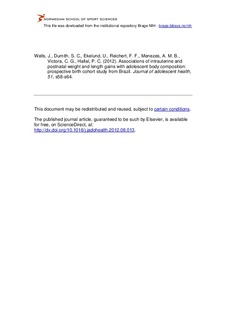| dc.contributor.author | Wells, Jonathan | |
| dc.contributor.author | Dumith, Samuel C. | |
| dc.contributor.author | Ekelund, Ulf | |
| dc.contributor.author | Reichert, Felipe F. | |
| dc.contributor.author | Menezes, Ana MB | |
| dc.contributor.author | Victora, Cesar G. | |
| dc.contributor.author | Hallal, Pedro C. | |
| dc.date.accessioned | 2013-01-31T08:24:05Z | |
| dc.date.accessioned | 2013-02-01T04:06:10Z | |
| dc.date.available | 2013-01-31T08:24:05Z | |
| dc.date.available | 2013-02-01T04:06:10Z | |
| dc.date.issued | 2012 | |
| dc.identifier | Seksjon for idrettsmedisinske fag / Department of Sports Medicine | |
| dc.identifier.citation | Journal of Adolescent Health. 2012, 51(6), s58-s64 | |
| dc.identifier.issn | 1054-139X | |
| dc.identifier.uri | http://hdl.handle.net/11250/170944 | |
| dc.description | I Brage finner du siste tekst-versjon av artikkelen, og den kan inneholde ubetydelige forskjeller fra forlagets pdf-versjon. Forlagets pdf-versjon finner du på www.sciencedirect.com: http://dx.doi.org/10.1016/j.jadohealth.2012.08.013 / In Brage you'll find the final text version of the article, and it may contain insignificant differences from the journal's pdf version. The definitive version is available at www.sciencedirect.com: http://dx.doi.org/10.1016/j.jadohealth.2012.08.013 | |
| dc.description.abstract | Purpose: Early growth patterns have been associated with subsequent obesity risk. However, findings from middle-income populations suggest that early infant growth may benefit lean mass and height rather than adiposity. We tested the hypothesis that rapid weight or length gain in different growth periods would be associated with size and body composition in adolescence, in a prospective birth cohort from southern Brazil.
Methods: Body composition was assessed in 425 adolescents (52.2% male) at 14 years. Exposures were birth weight z-score and conditional growth in weight or length for the periods 0–6, 6–12 and 12–48 months. Differences in anthropometric and body composition outcomes between tertiles of growth in each period were tested by one-way analysis of variance.
Results: Size at birth and conditional weight and length at 6 months were associated with later height. The effect of infant weight gain on lean mass was greater for males than females, and effect on fat mass greater for females than males. By early childhood, rapid weight gain generated relatively similar effects on both tissue masses in both sexes. Rapid length gain had stronger effects on outcomes in males than females at each time point, and benefited lean mass more than adiposity. All effects were substantially attenuated after adjusting for current height. Early weight gain was more important than length gain at influencing body composition outcomes in adolescence.
Conclusions: Rapid infant weight and length gains were primarily associated with larger size in adolescence rather than increased adiposity. From one year onwards, associations between rapid weight gain and fat and lean masses remained after adjustment for height. | |
| dc.language.iso | eng | |
| dc.publisher | Elsevier | |
| dc.subject | body composition | |
| dc.subject | growth | |
| dc.subject | obesity | |
| dc.subject | nutritional programming | |
| dc.title | Associations of Intrauterine and Postnatal Weight and Length Gains With Adolescent Body Composition: Prospective Birth Cohort Study From Brazil | |
| dc.type | Journal article | |
| dc.type | Peer reviewed | |
| dc.subject.nsi | VPD::Medical disciplines: 700 | |
| dc.source.pagenumber | s58-s64 | |
| dc.source.volume | 51 | |
| dc.source.journal | Journal of Adolescent Health | |
| dc.source.issue | 6 | |
| dc.identifier.doi | 10.1016/j.jadohealth.2012.08.013 | |
